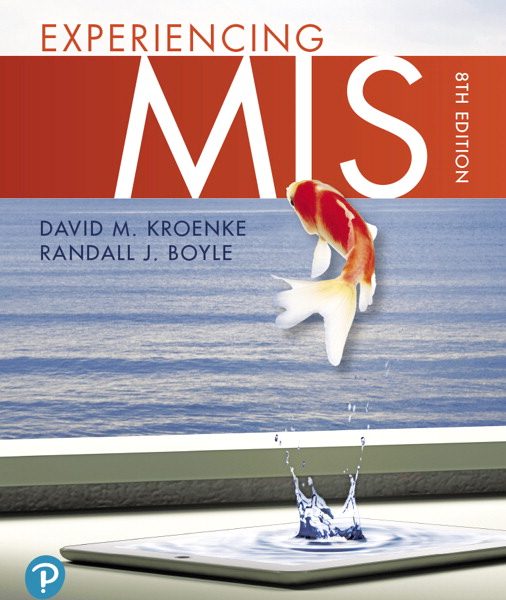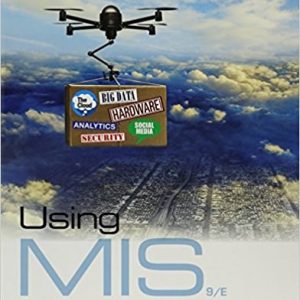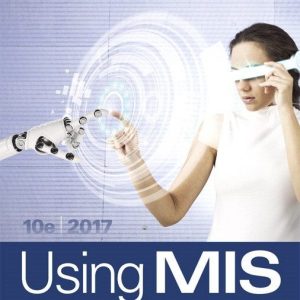This is completed downloadable of Test Bank for Experiencing MIS 8th by Kroenke

Product Details:
- ISBN-10 : 1292266988
- ISBN-13 : 978-1292266985
- Author:
As technology continues to change the way organizations do business, knowledge of MIS is critical. Experiencing MIS illustrates how organizations use information systems to solve business problems every day. This modular text uses illustrative cases, exercises, projects, and other aids to ensure students connect concepts to everyday life by making MIS interesting and relevant to them. Changes and highlights in the 8th Edition keep pace with the fast-moving world of MIS and keep students up to date and knowledgeable on how to apply emerging technologies to better achieve their organization’s strategies. Unique and updated guides within each chapter highlight themes in ethics, security, MIS careers, and other timely topics.
Table of Content:
- Part 1: Why MIS?
- Chapter 1: The Importance of MIS
- 1. Why Is Introduction to MIS the Most Important Class in the Business School?
- The Digital Revolution
- Evolving Capabilities
- Moore’s Law
- Metcalfe’s Law
- Other Forces Pushing Digital Change
- This is the Most Important Class in the School of Business
- 2. How Will MIS Affect Me?
- How Can I Attain Job Security?
- How Can Intro to MIS Help You Learn Nonroutine Skills?
- 3. Why Are MIS-Related Jobs in High Demand?
- What is the Bottom Line?
- So What?: A Is for Alphabet
- 4. What Is MIS?
- Components of an Information System
- Management and use of Information Systems
- Achieving Strategies
- 5. What Is Your Role in IS Security?
- Strong Passwords
- Password Etiquette
- How does the knowledge in this chapter help you?
- Ethics Guide Ethics and Professional Responsibility
- Career Guide Five-Component Careers
- Case Study 1: zulily
- Chapter 2: Business Processes, Information Systems, and Information
- 1. Why Does the Falcon Security Team Need to Understand Business Processes?
- 2. How Can Business Process Modeling Help Organizations?
- How Best Bikes Works
- The Existing Best Bikes Process
- How Best Bikes Processes Must Change to Support 3D Printing
- 3. How Can Information Systems Improve Process Quality?
- What Is Process Quality?
- Using Information Systems to Improve Process Quality
- 4. What Is Information?
- Definitions Vary
- Where Is Information?
- So What?: Augmented Collaboration
- 5. What Data Characteristics are Necessary for Quality Information?
- Accurate
- Timely
- Relevant
- Just Barely Sufficient
- Worth Its Cost
- How does the Knowledge in this Chapter Help you?
- Ethics Guide Big Brother Wearables
- Career Guide Senior Product Manager
- Case Study 2: Eating Our Own Dog Food
- Chapter 3: Organizational Strategy, Information Systems, and Competitive Advantage
- 1. How Does Organizational Strategy Determine Information Systems Structure?
- 2. What Five Forces Determine Industry Structure?
- 3. What Is Competitive Strategy?
- 4. How Does Competitive Strategy Determine Value Chain Structure?
- Primary Activities in the Value Chain
- Support Activities in the Value Chain
- Value Chain Linkages
- 5. How Do Value Chains Determine Business Processes and Information Systems?
- 6. How Do Information Systems Provide Competitive Advantages?
- So What?: The Autonomous Race
- Competitive Advantage Via Products
- Competitive Advantage Via Business Processes
- How Can an Organization Use is to Create Competitive Advantages?
- How Does this System Create a Competitive Advantage?
- How does the Knowledge in this Chapter Help you?
- Ethics Guide The Lure of Love Bots
- Career Guide V.P. of Architecture
- Case Study 3: The Amazon of Innovation
- Part 2: Information Technology
- Chapter 4: Hardware and Software
- 1. What Do Business Professionals Need to Know About Computer Hardware?
- Hardware Components
- Types of Hardware
- Computer Data
- 2. How Can New Hardware Affect Competitive Strategies?
- The Internet of Things
- Digital Reality Devices
- Self-Driving Cars
- So What?: New from CES 2017
- 3. What Do Business Professionals Need to Know About Software?
- What Are The Major Operating Systems?
- Virtualization
- Owning Versus Licensing
- What Types of Applications Exist, and How Do Organizations Obtain Them?
- What Is Firmware?
- 4. Is Open Source Software a Viable Alternative?
- Why Do Programmers Volunteer Their Services?
- How Does Open Source Work?
- So, Is Open Source Viable?
- How does the Knowledge in this Chapter Help you?
- Ethics Guide Free Apps for Data
- Career Guide Supportability Program Manager
- Case Study 4: The Apple of Your i
- Chapter 5: Database Processing
- 1. Why Do You Need to Know About Databases?
- Reasons for Learning Database Technology
- What Is the Purpose of a Database?
- 2. What Is a Database?
- Relationships Among Rows
- Metadata
- 3. What Is a Database Management System (DBMS)?
- So What?: Slick Analytics
- 4. How Do Database Applications Make Databases More Useful?
- Traditional Forms, Queries, Reports, and Applications
- Browser Forms, Reports, Queries, and Applications
- Multiuser Processing
- 5. How Can Falcon Security Benefit from a Database System?
- 6. What Are Nontraditional DBMS Products?
- Need to Store New Data Types Differently
- Need for Faster Processing Using Many Servers
- Nontraditional DBMS Types
- Will these New Products Replace the Relational Model?
- What Do Nonrelational DBMS Mean for you?
- How does the Knowledge in this Chapter Help you?
- Ethics Guide Querying Inequality?
- Career Guide Senior Database Engineer
- Case Study 5: Searching for Pianos
- Chapter 6: The Cloud
- 1. Why Is the Cloud the Future for Most Organizations?
- Cloud Computing
- Why do Organizations Prefer the Cloud?
- When Does the Cloud Not Make Sense?
- 2. How Do Organizations Use the Cloud?
- Resource Elasticity
- Pooling Resources
- Over the Internet
- Cloud Services from Cloud Vendors
- Content Delivery Networks
- Using Web Services Internally
- 3. How Can Falcon Security Use the Cloud?
- SaaS Services at Falcon Security
- PaaS Services at Falcon Security
- IaaS Services at Falcon Security
- 4. How Can Organizations Use Cloud Services Securely?
- Virtual Private Network (VPN)
- Using a Private Cloud
- Using a Virtual Private Cloud
- So What?: Quantum Learning
- 5. What Does the Cloud Mean for Your Future?
- How does the Knowledge in this Chapter Help you?
- Ethics Guide Cloudy Profit?
- Career Guide Senior Network Manager
- Case Study 6: Cloud Solutions That Test for Consumer Risk and Financial Stability
- Part 3: Using IS for Competitive Advantage
- Chapter 7: Processes, Organizations, and Information Systems
- 1. How Do Information Systems Vary by scope?
- Personal Information Systems
- Workgroup Information Systems
- Enterprise Information Systems
- Inter-Enterprise Information Systems
- 2. How Do Enterprise Systems Solve the Problems of departmental Silos?
- What Are the Problems of Information Silos?
- How Do Organizations Solve the Problems of Information Silos?
- An Enterprise System for Patient Discharge
- Business Process Reengineering
- 3. How Do CRM, ERP, and EAI Support Enterprise Systems?
- Customer Relationship Management (CRM)
- So What?: Workflow Problems
- Enterprise Resource Planning (ERP)
- Enterprise Application Integration (EAI)
- What are the Challenges when Implementing and Upgrading Enterprise Systems?
- 4. How Do Inter-enterprise IS Solve the Problems of Enterprise Silos?
- How does the Knowledge in this Chapter Help you?
- Ethics Guide Paid Deletion
- Career Guide IT Technical Manager
- Case Study 7: Interorganizational IS: The National Programme for IT in the NHS
- Chapter 8: Social Media Information Systems
- 1. What Is a Social Media Information System (SMIS)?
- Three SMIS Roles
- SMIS Components
- 2. How Do SMIS Advance Organizational Strategy?
- Social Media and The Sales and Marketing Activity
- Social Media and Customer Service
- Social Media and Inbound and Outbound Logistics
- Social Media and Manufacturing and Operations
- Social Media and Human Resources
- So What?: Enhanced Golf Fan
- 3. How Do SMIS Increase Social Capital?
- What Is the Value of Social Capital?
- How Do Social Networks Add Value to Businesses?
- Using Social Networking to Increase The Number of Relationships
- Using Social Networks to Increase the Strength of Relationships
- Using Social Networks to Connect to Those with More Resources
- 4. How Do (Some) Companies Earn Revenue from Social Media?
- You Are the Product
- Revenue Models for Social Media
- Does Mobility Reduce Online Ad Revenue?
- 5. How Can Organizations Address SMIS Security Concerns?
- Managing the Risk of Employee Communication
- Managing the Risk of Inappropriate Content
- 6. Where Is Social Media Taking US?
- How does the Knowledge in this Chapter Help you?
- Ethics Guide Synthetic Friends
- Career Guide Freelance Digital Marketer & Content Creator
- Case Study 8: Inverness Community Social Media
- Chapter 9: Business Intelligence Systems
- 1. How Do Organizations Use Business Intelligence (BI) Systems?
- How Do Organizations Use BI?
- What Are Typical Uses for Business Intelligence?
- 2. What Are the Three Primary Activities in the BI Process?
- Using Business Intelligence to Find Candidate Parts
- 3. How Do Organizations Use Data Warehouses and Data Marts to Acquire Data?
- Problems with Operational Data
- Data Warehouses Versus Data Marts
- 4. What Are Three Techniques for Processing BI Data?
- Reporting Analysis
- Data Mining Analysis
- Big Data
- 5. What Are the Alternatives for Publishing BI?
- Characteristics of BI Publishing Alternatives
- So What?: BI for Securities Trading?
- What Are the Two Functions of a BI Server?
- How does the Knowledge in this Chapter Help you?
- Ethics Guide MIS-diagnosis
- Career Guide Senior Technical Analyst
- Case Study 9: App and Pan-App Data Mining
- Part 4: Information Systems Management
- Chapter 10: Information Systems Security
- 1. What Is the Goal of Information Systems Security?
- The IS Security Threat/Loss Scenario
- What Are the Sources of Threats?
- What Types of Security Loss Exist?
- Goal of Information Systems Security
- 2. How Big Is the Computer Security Problem?
- 3. How Should You Respond to Security Threats?
- 4. How Should Organizations Respond to Security Threats?
- So What?: New from Black Hat 2016
- 5. How Can Technical Safeguards Protect Against Security Threats?
- Identification and Authentication
- Single Sign-on for Multiple Systems
- Encryption
- Firewalls
- Malware Protection
- Design for Secure Applications
- 6. How Can Data Safeguards Protect Against Security Threats?
- 7. How Can Human Safeguards Protect Against Security Threats?
- Human Safeguards for Employees
- Human Safeguards for Nonemployee Personnel
- Account Administration
- Systems Procedures
- Security Monitoring
- 8. How Should Organizations Respond to Security Incidents?
- How does the Knowledge in this Chapter Help you?
- Ethics Guide Exhaustive Cheating
- Career Guide Security Consultant
- Case Study 10: Hitting the Target
- Chapter 11: Information Systems Management
- 1. What Are the Functions and Organization of the IS Department?
- How Is the IS Department Organized?
- Security Officers
- What IS-related Job Positions Exist?
- 2. How Do Organizations Plan the Use of IS?
- Align Information Systems with Organizational Strategy
- Communicate IS Issues to the Executive Group
- Develop Priorities and Enforce Them Within the IS Department
- Sponsor the Steering Committee
- 3. What Are the Advantages and Disadvantages of Outsourcing?
- Outsourcing Information Systems
- So What?: Managing the IS Department
- International Outsourcing
- What Are the Outsourcing Alternatives?
- What Are the Risks of Outsourcing?
- 4. What Are Your User Rights and Responsibilities?
- Your User Rights
- Your User Responsibilities
- How does the Knowledge in this Chapter Help you?
- Ethics Guide Training Your Replacement
- Career Guide Senior Data Analyst
- Case Study 11: Automating Labor
- Chapter 12: Information Systems Development
- 1. What Is Systems Development?
- 2. Why Is Systems Development Difficult and Risky?
- The Difficulty of Requirements Determination
- Changes in Requirements
- Scheduling and Budgeting Difficulties
- Changing Technology
- Diseconomies of Scale
- Is It Really So Bleak?
- 3. What Are the Five Phases of the SDLC?
- 4. How Is System Definition Accomplished?
- Define System Goals and Scope
- Assess Feasibility
- Form a Project Team
- 5. What Is the Users’ Role in the Requirements Phase?
- Determine Requirements
- Approve Requirements
- Role of a Prototype
- 6. How Are the Five Components Designed?
- So What?: Banking on IoT
- Hardware Design
- Software Design
- Database Design
- Procedure Design
- Design of Job Descriptions
- 7. How Is an Information System Implemented?
- System Testing
- System Conversion
- 8. What Are the Tasks for System Maintenance?
- 9. What Are Some of the Problems with the SDLC?
- The SDLC Waterfall
- Requirements Documentation Difficulty
- Scheduling and Budgeting Difficulties
- How does the Knowledge in this Chapter Help you?
- Ethics Guide Estimation Ethics
- Career Guide Developing Your Personal Brand
- Case Study 12: When Will We Learn?
- Chapter Extension 1: Collaboration Information Systems for Decision Making, Problem Solving, and Pro
- 1. What Are the Two Key Characteristics of Collaboration?
- Importance of Constructive Criticism
- Guidelines for Giving and Receiving Constructive Criticism
- Warning!
- 2. What Are Three Criteria for Successful Collaboration?
- Successful Outcome
- Growth in Team Capability
- Meaningful and Satisfying Experience
- 3. What Are the Four Primary Purposes of Collaboration?
- Becoming Informed
- Making Decisions
- Solving Problems
- Managing Projects
- 4. What Are the Components and Functions of a Collaboration Information System?
- The Five Collaboration System Components
- Primary Functions: Communication and Content Sharing
- Chapter Extension 2: Collaborative Information Systems for Student Projects
- 1. What Are the IS Requirements for Student Project Collaborations?
- Required Features
- Nice-to-Have Features
- Collaboration Tool Characteristics
- 2. How Can You Use Collaboration Tools to Improve Team Communication?
- 3. How Can You Use Collaboration Tools to Share Content?
- Shared Content with no Control
- Shared Content with Version Management on Google Drive
- Shared Content with Version Control
- 4. How Can You Use Collaboration Tools to Manage Tasks?
- Sharing a Task List on Google Drive
- Sharing a Task List Using Microsoft Sharepoint
- 5. Which Collaboration Information System Is Right for Your Team?
- The Minimal Collaboration Tool Set
- The Good Collaboration Tool Set
- The Comprehensive Collaboration Tool Set
- Choosing the Set For Your Team
- Don’t Forget Procedures and People!
- Chapter Extension 3: Mobile Systems
- 1. What Are Mobile Systems?
- 2. Why Are Mobile Systems Important?
- Hardware
- Software
- Data
- Procedures
- People
- 3. How Do Native and Web-based Mobile Applications Compare?
- Developing Native Mobile Applications
- Developing Web Mobile Applications
- Which Is Better?
- 4. What Characterizes Quality Mobile User Experiences?
- Feature Content
- Use Context-Sensitive Chrome
- Provide Animation and Lively Behavior
- Design to Scale and Share
- Use the Cloud
- 5. What Are the Challenges of Personal Mobile Devices at Work?
- Advantages and Disadvantages of Employee Use of Mobile Systems at Work
- Survey of Organizational BYOD Policy
- Chapter Extension 4: Introduction to Microsoft Excel 2016
- 1. What Is a Spreadsheet?
- 2. How Do You Get Started with Excel?
- 3. How Can You Enter Data?
- Key in the Data
- Let Excel add the Data Using a Pattern
- 4. How Can You Insert and Delete Rows and Columns and Change Their Size?
- 5. How Can You Format Data?
- 6. How Can You Create a (Simple) Formula?
- 7. How Can You Print Results?
- Chapter Extension 5: Database Design
- 1. Who Will Volunteer?
- 2. How Are Database Application Systems Developed?
- 3. What are the Components of the Entity-Relationship Data Model?
- Entities
- Relationships
- 4. How Is a Data Model Transformed into a Database Design?
- Normalization
- Representing Relationships
- 5. What Is the Users’ Role?
- 6. Who Will Volunteer? (Continued)
- Chapter Extension 6: Using Microsoft Access 2016
- 1. How Do You Create Tables?
- Starting Access
- Creating Tables
- 2. How Do You Create Relationships?
- 3. How Do You Create a Data Entry Form?
- 4. How Do You Create Queries Using the Query Design Tool?
- 5. How Do You Create a Report?
- Chapter Extension 7: Using Excel and Access Together
- 1. Why Use Excel and Access Together?
- 2. What Is Import/Export?
- Import/Export of Text Data
- Import/Export of Excel and Access Data
- 3. How Can You Create Charts with Excel?
- Creating a Pie Chart
- Creating a Column Chart
- 4. How Can You Create Group Totals in Access?
- 5. How Can You Use Excel to Graph Access Data?
- 6. How Can You Use Access to Report Excel Data?
- 7. How Can You Combine Excel and Access to Analyze Data?
- Chapter Extension 8: Network and Cloud Technology
- 1. What Is a Computer Network?
- 2. What Are the Components of a LAN?
- Connecting Your LAN to the Internet
- 3. How Does the Internet Work?
- The Internet and the U.S. Postal System
- Step 1: Assemble Package (Packets)
- Step 2: Put Name on Package (Domain Names)
- Step 3: Look Up Address (IP Address)
- Step 4: Put Address on Package (IP Address on Packet)
- Step 5: Put Registered Mail Sticker on Package (TCP)
- Step 6: Ship Package (Packets Transported by Carriers)
- 4. How Do Web Servers Support the Cloud?
- Three-Tier Architecture
- Watch the Three Tiers in Action!
- Service-Oriented Architecture (SOA)
- Internet Protocols
- TCP/IP Protocol Architecture
- Chapter Extension 9: Enterprise Resource Planning (ERP) Systems
- 1. What Is the Purpose of ERP Systems?
- 2. What Are the Elements of an ERP Solution?
- Hardware
- Software: ERP Application Programs
- Data: ERP Databases
- Procedures: Business Process Procedures
- People: Training and Consulting
- 3. How Are ERP Systems Implemented and Upgraded?
- 4. What Types of Organizations Use ERP?
- ERP by Industry Type
- ERP by Organization Size
- International ERP
- 5. How Do the Major ERP Vendors Compare?
- ERP Market Leaders
- ERP Products
- ERP in the Future
- Chapter Extension 10: Supply Chain Management
- 1. What Are Typical Inter-Enterprise Processes?
- 2. What Is a Supply Chain?
- 3. What Factors Affect Supply Chain Performance?
- 4. How Does Supply Chain Profitability Differ from Organizational Profitability?
- 5. What Is the Bullwhip Effect?
- 6. How Do Information Systems Affect Supply Chain Performance?
- Chapter Extension 11: Enterprise Social Networks and Knowledge Management
- 1. How Do Organizations Develop an Effective SMIS?
- Step 1: Define Your Goals
- Step 2: Identify Success Metrics
- Step 3: Identify the Target Audience
- Step 4: Define Your Value
- Step 5: Make Personal Connections
- Step 6: Gather and Analyze Data
- 2. What Is an Enterprise Social Network (ESN)?
- Enterprise 2.0
- Changing Communication
- Deploying Successful Enterprise Social Networks
- 3. What Are the Benefits of Knowledge Management?
- 4. What Are Expert Systems?
- 5. What Are Content Management Systems?
- What Are the Challenges Of Content Management?
- What Are Content Management Application Alternatives?
- Chapter Extension 12: Database Marketing
- 1. What Is a Database Marketing Opportunity?
- 2. How Does RFM Analysis Classify Customers?
- 3. How Does Market-Basket Analysis Identify Cross- Selling Opportunities?
- 4. How Do Decision Trees Identify Market Segments?
- A Decision Tree for Student Performance
- A Decision Tree for Loan Evaluation
- Chapter Extension 13: Reporting Systems and OLAP
- 1. How Do Reporting Systems Enable People to Create Information?
- 2. What Are the Components and Characteristics of Reporting Systems?
- Report Type
- Report Media
- Report Mode
- 3. How Are Reports Authored, Managed, and Delivered?
- Report Authoring
- Report Management
- Report Delivery
- 4. How Are OLAP Reports Dynamic?
- Chapter Extension 14: Artificial Intelligence and Automation
- 1. Why Is Artificial Intelligence Important?
- Advances in AI
- 2. How Will AI and Automation Affect Organizations?
- Benefits of Automated Labor
- 3. How Will AI Affect Me?
- Unwanted Dirty Jobs
- Retraining and Retooling
- Surviving a Shifting Workplace
- 4. What Is the Goal of AI?
- Integrated Enabler of Other Technology
- 5. How Does AI Work?
- Machine Learning
- IBM’s Watson
- Chapter Extension 15: Data Breaches
- 1. What Is a Data Breach?
- Why Do Data Breaches Happen?
- 2. How Do Data Breaches Happen?
- Hitting Target
- How Did they Do It?
- The Damage
- 3. How Should Organizations Respond to Data Breaches?
- Respond Quickly
- Plan for a Data Breach
- Be Honest about the Breach
- 4. What Are the Legal Consequences of a Data Breach?
- 5. How Can Data Breaches be Prevented?
- Chapter Extension 16: International MIS
- 1. How Does the Global Economy Affect Organizations and Processes?
- How Does the Global Economy Change the Competitive Environment?
- How Does the Emerging Global Economy Change Competitive Strategy?
- Career Guide Director, Asian Operations
- How Does the Global Economy Change Value Chains and Business Processes?
- 2. What Are the Characteristics of International IS Components?
- What’s Required to Localize Software?
- IBM’s Watson Learns Korean
- What Are the Problems and Issues of Global Databases?
- What Are the Challenges of International Enterprise Applications?
- 3. How Do Inter-Enterprise IS Facilitate Globalization?
- How Do Global Information Systems Affect Supply Chain Profitability?
- What Is the Economic Effect of Global Manufacturing?
- How Does Social Media Affect International Business?
- 4. What Are the Security Challenges of International IS?
- Legal Environment
- Physical Security
- Cultural Norms
- 5. What Are the Challenges of International IS Management?
- Why Is International Information Systems Development More Challenging?
- What Are the Challenges of International Project Management?
- What Are the Challenges of International IS Management?
- Chapter Extension 17: Systems Development Project Management
- 1. Why Is Formalized Project Management Necessary?
- 2. What Are the Trade-Offs in Requirements, Cost, and Time?
- 3. What Are the Dimensions of Project Management?
- 4. How Does a Work Breakdown Structure Drive Project Management?
- 5. What Is the Biggest Challenge for Planning a Systems Development Project?
- 6. What Are the Biggest Challenges for Managing a Systems Development Project?
- 7. What Is the Single Most Important Task for Users on a Systems Development Project?
- Chapter Extension 18: Agile Development
- 1. Why Is the SDLC Losing Credibility?
- 2. What Are the Principles of Agile Development Methodologies?
- 3. What Is the Scrum Process?
- Scrum Essentials
- When Are We Done?
- Key Roles
- 4. How Do Requirements Drive the Scrum Process?
- Creating Requirements Tasks
- Scheduling Tasks
- Committing to Finish Tasks
- Hocus-Pocus?
- Chapter Extension 19: Business Process Management
- 1. Why Do Organizations Need to Manage Business Processes?
- A Sample Ordering Business Process
- Why Does this Process Need Management?
- 2. What Are the Stages of Business Process Management (BPM)?
- 3. How Do Business Processes and Information Systems Relate?
- 4. Which Come First: Business Processes or Information Systems?
- Business Processes First
- Information System First
- Another Factor: Off-the-Shelf Software
- And the Answer Is
- 5. How Is BPM Practiced in the Real World?
- Defining the Process Problem
- Designing the New Process
- Create Process Components
- Implement New Processes
- Application Exercises
- Glossary
- Index





